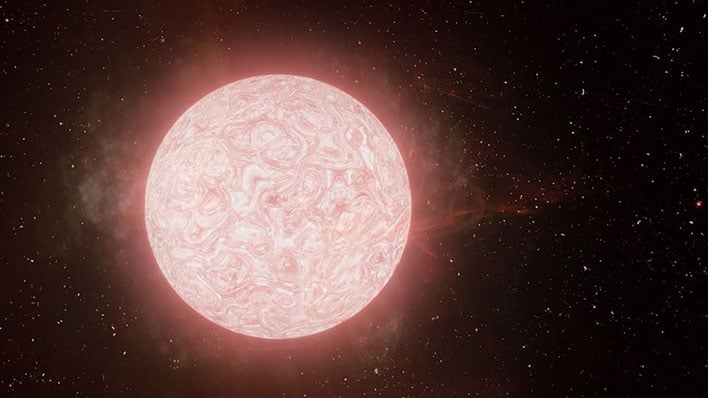Astronomers Are Awestruck Witnessing The Death Of A Gigantic Star For The First Time

What do the final months or days of a dying star look like? Human beings have observed supernovae but there is still so much to learn about them. This includes the warning signs that different kinds of stars release. Scientists for the very first time recently witnessed the destruction of a red supergiant star several months before it collapsed into a Type II supernova.
The Young Supernova Experiment transient survey used two telescopes to observe the phenomena—the University of Hawaiʻi Institute for Astronomy Pan-STARRS on Haleakalā, Maui and W. M. Keck Observatory on Maunakea, Hawaiʻi Island. They noted that light was radiating from the red supergiant in Summer 2020. They observed what the star did for 130 days before it collapsed into a Type II supernova in September 2020. They then "captured the powerful flash and obtained the very first spectrum of the energetic explosion." They continued to keep an eye out on the supernova after the explosion. The supernova has since been dubbed "supernova 2020tlf," or "SN 2020tlf."
Wynn Jacobson-Galán, an NSF Graduate Research Fellow at UC Berkeley, remarked, "This is a breakthrough in our understanding of what massive stars do moments before they die. Direct detection of pre-supernova activity in a red supergiant star has never been observed before in an ordinary Type II supernova. For the first time, we watched a red supergiant star explode!"
The study completely alters what we know about how red supergiants die. Scientists had never before witnessed the explosions that they observed with this particular star and therefore believed that red supergiants died quietly before becoming supernovas. This study argues that at least some red supergiants go out with a bang. The team noted that this discovery will help us to better recognize dying stars. Furthermore, Jacobson-Galán stated that it "...will dramatically impact how we define the final months of stellar evolution, uniting observers and theorists in the quest to solve the mystery on how massive stars spend the final moments of their lives."
The red supergiant was 120 million lightyears from Earth in the NGC 5731 galaxy. The NGC 5731 galaxy is a spiral galaxy located in the Boötes Constellation. The star had ten times the mass of our Sun. Type II supernovae occur when a star with between eight to fifty times the mass of our Sun rapidly collapses and explodes. The Swinburne University of Technology in Australia notes that Type II supernovae are further "characterized by hydrogen emission in their spectra." They are common in the spiral arms of galaxies like the 5731 galaxy.
"An artist’s rendition of a red supergiant star transitioning into a Type II supernova." Image courtesy of W. M. Keck Observatory/Adam Makarenko.
The Young Supernova Experiment transient survey used two telescopes to observe the phenomena—the University of Hawaiʻi Institute for Astronomy Pan-STARRS on Haleakalā, Maui and W. M. Keck Observatory on Maunakea, Hawaiʻi Island. They noted that light was radiating from the red supergiant in Summer 2020. They observed what the star did for 130 days before it collapsed into a Type II supernova in September 2020. They then "captured the powerful flash and obtained the very first spectrum of the energetic explosion." They continued to keep an eye out on the supernova after the explosion. The supernova has since been dubbed "supernova 2020tlf," or "SN 2020tlf."
Wynn Jacobson-Galán, an NSF Graduate Research Fellow at UC Berkeley, remarked, "This is a breakthrough in our understanding of what massive stars do moments before they die. Direct detection of pre-supernova activity in a red supergiant star has never been observed before in an ordinary Type II supernova. For the first time, we watched a red supergiant star explode!"
The study completely alters what we know about how red supergiants die. Scientists had never before witnessed the explosions that they observed with this particular star and therefore believed that red supergiants died quietly before becoming supernovas. This study argues that at least some red supergiants go out with a bang. The team noted that this discovery will help us to better recognize dying stars. Furthermore, Jacobson-Galán stated that it "...will dramatically impact how we define the final months of stellar evolution, uniting observers and theorists in the quest to solve the mystery on how massive stars spend the final moments of their lives."
The red supergiant was 120 million lightyears from Earth in the NGC 5731 galaxy. The NGC 5731 galaxy is a spiral galaxy located in the Boötes Constellation. The star had ten times the mass of our Sun. Type II supernovae occur when a star with between eight to fifty times the mass of our Sun rapidly collapses and explodes. The Swinburne University of Technology in Australia notes that Type II supernovae are further "characterized by hydrogen emission in their spectra." They are common in the spiral arms of galaxies like the 5731 galaxy.
"An artist’s rendition of a red supergiant star transitioning into a Type II supernova." Image courtesy of W. M. Keck Observatory/Adam Makarenko.

